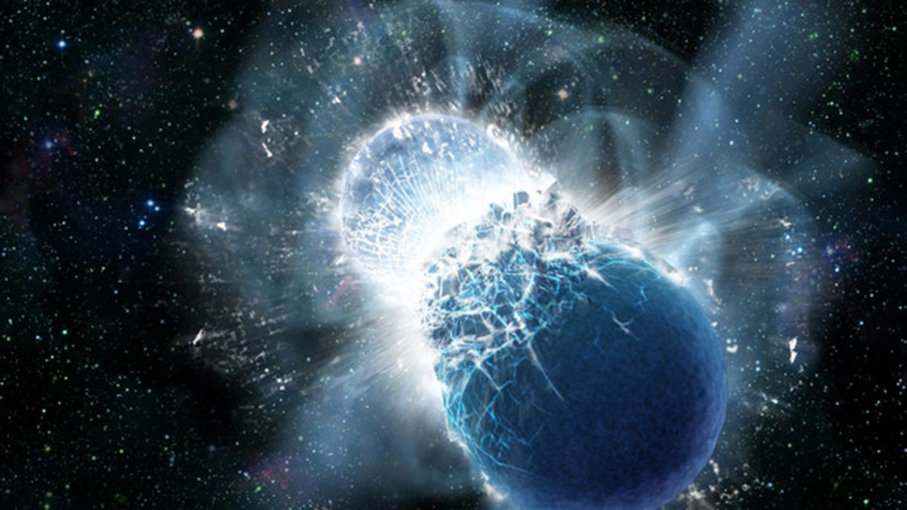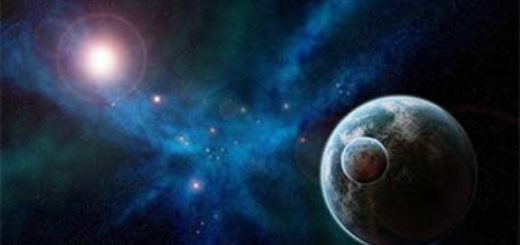Gravitational Waves Are Lifting the Veil of Cosmic Darkness

Artist’s depiction of a neutron star collision. A neutron star collision has caused one of the 11 gravitational wave signals detected thus far. NASA/SWIFT/DANA BERRY
It’s official: Scientists have detected so many gravitational wave signals that they need a special catalog to keep track. But that’s not all. They’ve added four new detections to the tally, and one of those signals was a double record-breaker.
Before we tell you about the double whammy, a recap: On Sept. 14, 2015, the Laser Interferometer Gravitational-wave Observatory, or LIGO, detected the first ever gravitational wave event caused by the collision of two black holes, located 1.3 billion light-years away. This Nobel prize-winning detection was a big deal. It took decades of work to build an advanced observatory capable of sensing the minute ripples in spacetime that are caused by some of the most energetic events triggered by the universe’s most massive objects. Since then, the Virgo detector, near Pisa, Italy, also has been tracking these events, boosting the precision of gravitational wave detections.
LIGO and Virgo also detected the first (and, currently, only) neutron star merger on Aug. 17, 2017.
So far, all the black hole mergers have been between stellar-mass black holes, or black holes that were likely formed after massive stars, a few dozen times the mass of our sun, died as supernovas. By counting the number of black hole collisions, we’ve opened an exquisite window into how often binary stellar-mass black holes merge in our universe. This, by extension, provides an estimate of how many stellar-mass black holes are lurking out there. Our current detectors, however, aren’t equipped to pick up the gravitational waves produced by the mergers of supermassive black holes.
From Einstein to Black Holes Going Bump in the Night
Albert Einstein famously predicted the existence of these waves in his historic general theory of relativity over 100 years ago, but it’s only now that technology has caught up. Since 2015, physicists have solidified Einstein’s predictions by detecting 11 events (10 by binary black holes and one by binary neutron stars).
You can visualize gravitational waves as ripples that are generated on the surface of a pond after a stone is dropped in the middle — the stone represents the energy generated at the moment of collision between black holes (or neutron stars), and the pond’s two-dimensional surface is a crude analogy of the three dimensions of space. The waves propagate at the speed of light and the more massive the colliding objects, the more energy is produced and therefore the more powerful the waves. As these waves ripple through our little corner of the universe, extremely sensitive gravitational wave interferometers (like LIGO and Virgo) can detect a minuscule space-time warp as the waves pass through our planet. What’s more, physicists can analyze these waves to decipher the nature of the colliding objects, such as how massive they were and how fast they were spinning before they smashed together.
It’s too early to say gravitational wave astronomy is “routine,” but as more observatories are constructed around the world, we’ll get better at pinpointing the origin of the waves (the location in the sky of the colliding massive objects) and picking up fainter (and therefore more distant and less energetic) events.
“In just one year, LIGO and VIRGO working together have dramatically advanced gravitational wave science, and the rate of discovery suggests the most spectacular findings are yet to come,” said Denise Caldwell in a statement. Caldwell is the director of the National Science Foundation’s division of physics.
And, as we mentioned, some of these new discoveries will be record breakers, like GW170729, one of the newly announced signals that occurred on July 29, 2017. This signal was generated by the collision and merger of two black holes that created a single black hole 80 times the mass of our sun. The smash-up happened in a distant galaxy approximately 5 billion years ago. This makes GW170729 the most massive and the most distant black hole merger detected yet.
Remember how we said the bigger the black holes, the more energetic their collision? In the process of colliding, this black hole smash-up converted five solar masses of black hole mass into pure energy. That’s why the signal was powerful enough to echo through the universe, washing over Earth 5 billion years later. The other three new (smaller and closer) gravitational wave detections include signals that were all detected in 2017 on Aug. 9, 18 and 23 — they have been named GW170809, GW170818, and GW170823 respectively. These new detections are detailed in two studies published on the preprint service arXiv.
Only the Beginning
Black holes are some of the most enigmatic objects in the universe. We know they’re out there, and now we even have direct measurements from their mergers via the gravitational ripples they create, but many mysteries remain. One of the biggest findings to come from this latest batch of discoveries is that astrophysicists can estimate, for the first time, that all stellar-mass black holes should be less than 45 times the mass of our sun when they emerge from their supernovas.
“Gravitational waves give us unprecedented insight into the population and properties of black holes,” said postdoctoral fellow Chris Pankow in a statement from Northwestern University and the Center for Interdisciplinary Exploration and Research in Astrophysics (CIERA). “We now have a sharper picture of both how frequently stellar mass binary black holes merge and what their masses are. These measurements will further enable us to understand how the most massive stars of our Universe are born, live and die.”
And guess what? This is only the beginning. More gravitational wave observatories are being planned around the world (and in space), and existing detectors are undergoing sensitivity upgrades.
All indications are that the new gravitational wave catalog will grow quickly over the coming years, shining a light on the dark events that occur in the furthest-most reaches of the cosmic expanse.



 Creators of mankind
Creators of mankind Description of “Tall white aliens”
Description of “Tall white aliens” Where they came from?
Where they came from? About hostile civilizations
About hostile civilizations The war for the Earth
The war for the Earth “Tall white aliens” about eternal life
“Tall white aliens” about eternal life Video: “Nordic aliens”
Video: “Nordic aliens” Aliens
Aliens Alien encounters
Alien encounters The aliens base
The aliens base UFO
UFO Technology UFO
Technology UFO Underground civilization
Underground civilization Ancient alien artifacts
Ancient alien artifacts Military and UFO
Military and UFO Mysteries and hypotheses
Mysteries and hypotheses Scientific facts
Scientific facts


















